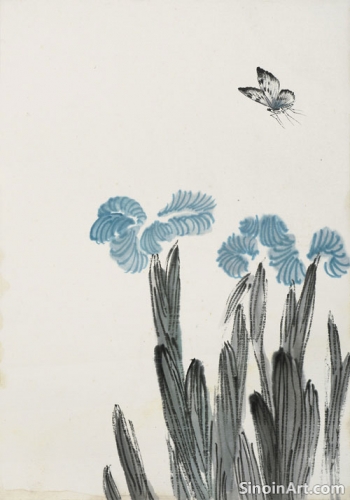The Use of "Side Brush" in Xieyi
|
The "Side Brush" or cèfēng (側鋒) technique is a crucial element of Xieyi brushwork, referring to holding the brush at an angle, rather than directly perpendicular to the paper. This technique creates lines and strokes with a distinct texture and character, allowing for greater expressiveness and dynamism. The angle of the brush greatly alters the expressive capabilities of the artwork.  When using the side of the brush, the artist can create strokes that vary in width and texture, from broad washes to thin, scratchy lines. The technique adds a new dimension of texture and expressive depth. The results are not as smooth as applying the brush directly, giving a more natural and spontaneous feeling.  The "side brush" is particularly effective for depicting textured surfaces, such as rocks, tree bark, and old buildings, as well as creating a sense of movement and dynamism. It can recreate the textures found in the natural world. It can enhance the impression of dynamic movement through the composition.  This technique allows the artist to achieve greater spontaneity, as the strokes are less controlled and more unpredictable. It creates visual effects that are difficult to achieve with other techniques. It allows for dynamic and creative expression. It is a valuable tool for the Xieyi painter. Mastering the "side brush" technique is essential for any Xieyi artist, requiring practice, skill, and a deep understanding of the brush's responsiveness. It is not simply a matter of holding the brush at an angle; it requires a skilled hand and a cultivated eye. The application requires control, intention, and purpose. |
Tag : Side brush technique, Cefeng, angled brush, textured strokes, Xieyi technique
Related information
- Contemporary Xieyi Artists to Explore
- Xieyi Painting and its Global Influence
- Xieyi Painting and the Use of "Splash Ink"
- The Spirit of Xieyi: An Introduction to Chinese Literati Painting
- Xieyi Painting and the Depiction of Water
Exploring the work of contemporary Xieyi artists reveals the ongoing evolution of this tradition, with artists incorporating abstraction, exploring social and political issues, experimenting with new techniques, and maintaining a connection to its core principles, thereby expanding the boundaries of the art form and ensuring its continued relevance in the modern world.
Xieyi painting has influenced artists and art movements globally through its emphasis on spontaneity, expression, and suggestion, with its impact seen in abstract expressionism and many contemporary approaches to the application of ink, form, and the expressive potential of line, reflecting its enduring power and universal appeal.
"Splash Ink" (pōmò) is a bold and expressive Xieyi technique, involving the free and spontaneous application of ink to create large washes and evoke movement and dynamism, emphasizing the unpredictable nature of ink and water and strategically used to create balance, depth, and vitality.
Xieyi, often translated as sketching thoughts or freehand style, is a significant genre within Chinese painting. It is characterized by its emphasis on capturing the essence and spirit of a subject rather than its exact appearance. This expressive, spontaneous approach prioritizes the artist's personal emotions and inner vision.
Water is a versatile subject in Xieyi, depicted through washes and expressive brushstrokes to convey fluidity, transparency, movement, and its symbolic connection to life, change, and nature, adding atmosphere and depth to landscape paintings, with varied forms representing a spectrum of feeling and power.